
Tropical ecosystems in the United States and its territories, including Puerto Rico, the U.S. Virgin Islands, American Samoa, and Guam, are located just north and south of the equator, within the tropics (between the latitudes of 23.5°N and 23.5°S). These regions experience warm temperatures and year-round rainfall, creating ideal conditions for a variety of ecosystems. The lowland rainforests are characterized by dense, towering trees and lush vegetation, while summer-deciduous forests shed their leaves during the dry season, offering a unique adaptation to seasonal changes. Woodland and scrub formations provide habitat for a wide range of wildlife, with open spaces and shrubs that support various bird and insect species.
Swamp and mangrove formations along coastal areas act as vital buffers for coastal protection, supporting diverse marine life and offering critical habitats for species like fish, crabs, and birds. The savanna areas are marked by grasses and scattered trees, supporting grazing animals and seasonal fires. In the montane rainforest regions, the cooler temperatures at higher elevations give rise to a rich tapestry of mosses, ferns, and cloud forests that support unique species, many of which are endemic. At even higher altitudes, alpine vegetation takes hold, characterized by hardy grasses, shrubs, and small trees adapted to the harsh, cooler conditions, providing shelter for high-elevation wildlife.
Together, these tropical ecosystems offer a critical refuge for biodiversity, while also providing essential services such as carbon storage, water filtration, and coastal protection.
There are National Natural Landmarks designated for tropical ecosystems. Some of these include:
- Le’ala Shoreline, AS
- Matafao Peak, AS
- Rainmaker Mountain, AS
- Archbold Biological Station, FL
- Big Cypress Bend, FL
- Corkscew Swamp Sanctuary, FL
- Lignumvitae Key, FL
- Reed Wilderness Seashore Sanctuary, FL
- Baño de Oro Natural Area, PR
- Cabo Rojo, PR
- Mona and Monito Islands, PR
- Rio Abajo Forest, PR
- Santa Ana National Wildlife Refuge, TX
Last updated: April 10, 2025
